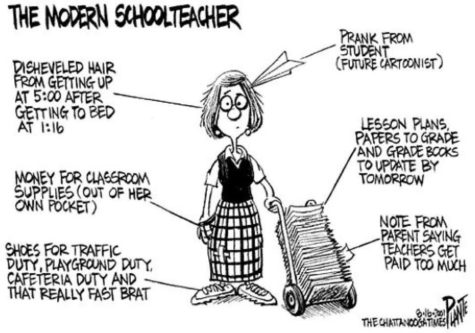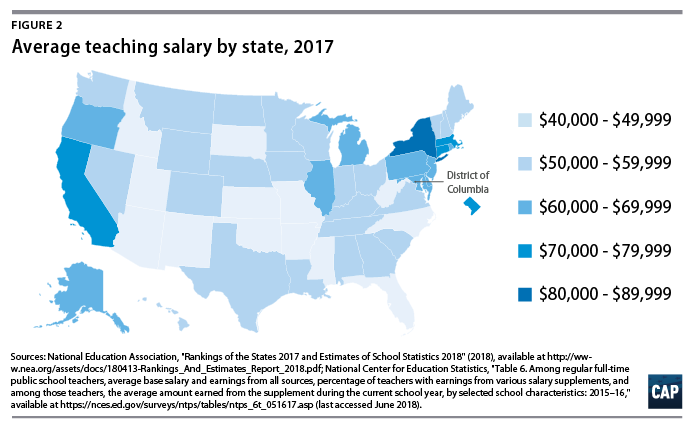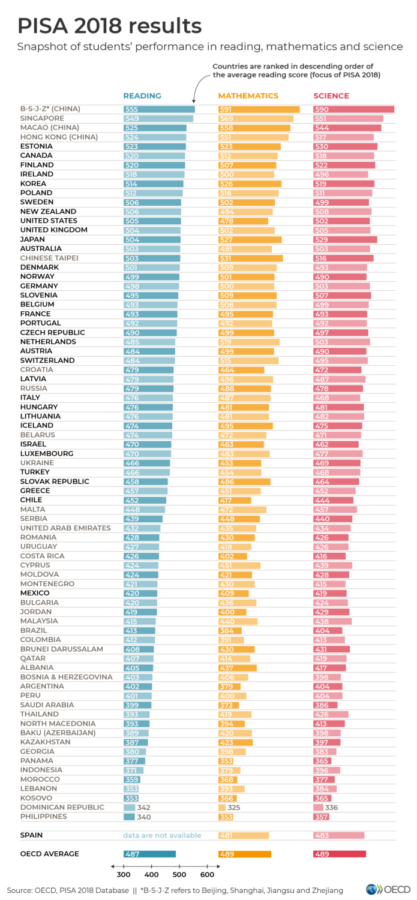America’s Rotten Apple
Understanding our country’s poor treatment of educators
In America, teaching is a thankless job. Educators work long hours preparing children for the future, yet receive very little appreciation.
It’s Teacher Appreciation Week across the U.S., as it is this time in May each year. But what ails the profession needs a cure much stronger than a week of gratitude.

The backbone of a successful society is education. It is the light that guides the pathway to a brighter future. It is the means through which underprivileged children can escape the bitter circumstances handed to them by the universe. It is the great equalizer. The importance of education can hardly be understated, and yet it is severely undervalued in the United States.
Nowhere is this more prevalent than in the treatment of educators in America. Three years ago we saw public school
teachers go on strike across the nation, protesting the unfavorable treatment they were being subjected to. They were not without good reason.
The average starting salary for a full time teacher is only $38,617 and the average teacher salary is $59,660. While these figures vary dramatically from state to state, what doesn’t change is the fact that teachers are underpaid across the country. In every state, public school teachers are paid less than employees who work jobs requiring similar skill and effort. And when compared to their college-educated, non-teaching peers, elementary, middle, and high school level teachers earned 19.2% less.

These low salaries have pushed about one in six teachers to pick up a second job during the school year. And underfunding for public schools in general has forced the burden of compensation onto the teachers themselves. A survey from the Department of Education found that 94% of public school teachers reported paying for supplies without reimbursement in the 2014 through 2015 school year. Teachers who took from their personal funds spent an annual average of $479 each.
It is blindingly clear that our nation is mistreating its educators, and it’s not as if we were unaware. The 50th annual PDK International Poll on public attitude towards education revealed that 54% of Americans do not want their children to become a public school teacher. The public is aware that education is a thankless job — one that offers a lot of stress but little benefit. Yet changes to the American education system remain to be seen.
Now, let’s set our sights overseas and compare America’s conduct towards teachers with that of other countries. Data scientists in the Organisation for Economic Cooperation and Development, or the OECD, often compare the U.S. with other other nations.
The Teaching and Learning International Survey (TALIS) for 2018 found that U.S. teachers work longer hours than just about every other OECD country at an average of 49.2 hours per week.
The same survey revealed that just 36% of U.S. teachers “agreed” or “strongly agreed” that American society values the teaching profession. This is still higher than the OECD average of 26%, but much lower than percentiles in other developed nations such as South Korea(67%) or Finland(58%).
The students from these countries also fared better on math, reading, and science sections of the OECD’s Program for International Student Assessment(PISA) exams. So maybe, just maybe, greater appreciation for teachers is the way to go.

Critics may argue that the United States spends more on education per student($15,908) than nearly any other country in the world. But the data can be confusing. It rasises the question over why the United States has such an issue with underfunded schools if we’re spending so much on education. The answer is that the number of dollars spent per pupil on education is an average of the entire country.
In the U.S., spending on education is decided on a state-by-state basis. And if we compare the spending per student by state, it’s immediately obvious that there are drastic inequalities. For example, New Jersey spends nearly twice as much per student as West Virginia. Unsurprisingly, New Jersey’s education is ranked first in the nation, while West Virginia’s is ranked 41st.
While low teacher salaries and underfunded public schools may not seem like issues that plague prosperous districts like North Allegheny, the neglect of education and educators is must be the concern of all Americans. It is sadly apparent that teachers are the ones who hold the gold key to student success, yet they are cast aside all too often
America can not hope to maintain its standing on the world stage if it continues to undervalue schooling. In a healthy society, education is the collective lifeline.

Michelle Hwang is a senior at NASH and the features editor for The Uproar. She enjoys reading, so if you happen to have any book recommendations, please send them her way. And if you happen to have spare slices of pecan pie lying around, send those her way too. She really likes pecan pie. She also likes making pros and cons lists with Claire Majerac. Not about pecan pie though. There are no cons to...

